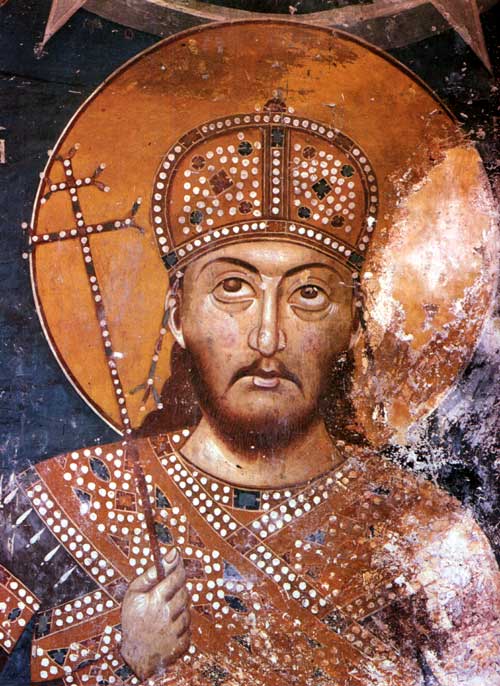
|
Stefan Nemanja seal.mp4 Size : 5141.946 Kb Type : mp4 |

|
Emperor Dusan replica crown.mov Size : 46611.243 Kb Type : mov |


|
Novac u Beogradu kroz vekove.pdf Size : 9263.425 Kb Type : pdf |
Fantastic idea to display Serbian medieval coins in Historical Museum of Serbia, Belgrade.
Nov 13th 2023.
Lead seal of Stefan Nemanja to return to Serbia after more then 830 years!
The lead seal of Grand Prince Stefan Nemanja, the progenitor of the Nemanjic Dynasty and the founder of the medieval Serbian state, has been purchased for the Historical Museum of Serbia, May 4th 2023.
Stefan Nemanja (1113/4-1199), Grand Prince of the Serbian Grand Principality (Raška).
Lead Seal, 2nd half of 12th century AD.
Obverse: St. Stefan standing, holding a small casket and a censer. Greek Cyrillic description: Ο/ ΣΤΕ/ ΦΑ/ ΝΟ/ C - Ο/ ΠAN/ ΤΟ/ ΜΑΡ/ ΤY/ C (SAINT STEFAN PANTOCRATOR MARTYR).
Reverse: Greek Cyrillic description in 6 lines: ΣΦΡΑΓΙC/ CTΕΦANOΥ/ ΜΕΓΑΛOΥ/ ΖΟΥΠΑΝΟΥ/ ΤΟΥ ΝΕΜΑ/ NIA (THE SEAL OF STEFAN THE GRAND PRINCE NEMANJA).
PB. 20.92 g. 35.00 mm. RRR. Extremely rare. About EF.
Email to registered buyers 3rd May 2023, 4 days before the end of auction:
'We inform you that lot 788, the lead seal of Stefan Nemanja (1113/4-1199), has been withdrawn from the auction and sold by private treaty to the Istorijski muzej Srbije - Historical Museum of Serbia.
The seal was published in our Artemide LIX auction in early April. Conferred as a simple Byzantine seal, it was correctly identified and classified by our experts, attributing it to Stefan Nemanja, one of the founding fathers of Serbia. The lot has aroused a lot of attention, not only among numismatists, but also among all Serbian history scholars. The Historical Museum of Serbia noticed the important object and contacted our auction house asking for a direct purchase option.
Although it is unusual for our auction house to withdraw lots offered at auction to sell them by private treaty, we have done our utmost to facilitate the negotiation between the Museum and the consignor of the lot.
With satisfaction for all parties, the negotiation was finalized today and soon this important seal will return to Serbia, to be exhibited in the national museum and to be admired by all the Serbian people and visitors from all over the world.'
Auction amount reached before private purchase was 8500 euros.

|
Stefan Nemanja seal.mp4 Size : 5141.946 Kb Type : mp4 |
Replica of Emperor Dušan's Crown Presented
The Historical Museum of Serbia has launced a project to construct replicas of crowns of the pre-Nemanjić, Nemanjić and post-Nemanjić period, within which the filigree artist Goran Ristović Pokimica from Kraljevo already made a replica of Emperor Dušan's crown based on the Serbian ruler's fresco from the Lesnovo Monastery. The crown will be part of the permanent exhibition of the Historical Museum of Serbia together with other crowns of Serbian medieval rulers that have already been made, such as the crown of Queen Helen of Anjou and the crown of Empress Helena or which will be made (the crowns of King Milutin, King Tvrtko I Kotromanić, Despote Stefan Lazarević).
By clicking on the image below original website will open:
The replica of Emperor Dušan's crown is 1694.81 grams heavy, it has 14 cultured rubies, 14 cultured sapphires, 16 oval rubies, 16 lapis lazuli, 12 amethysts and 304 freshwater pearls. It took six months to make the crown.
The difference between the original and the replica of the crown is in the metal that was used to make it. While the original crown was almost certainly made of gold, the replica is a silver-gilt object.

|
Emperor Dusan replica crown.mov Size : 46611.243 Kb Type : mov |

Fascinating collection of coins in Peoples museum Belgrade Serbia.

|
Novac u Beogradu kroz vekove.pdf Size : 9263.425 Kb Type : pdf |
This YouTube video contains some of the coins from our Serbian medieval coin collection from king Stefan Radoslav 1228-1234 to the king Stefan Tomasevic 1461-1463. Nearly 250 years of rich history and amazing coin design and variety.
Copyright © 2020